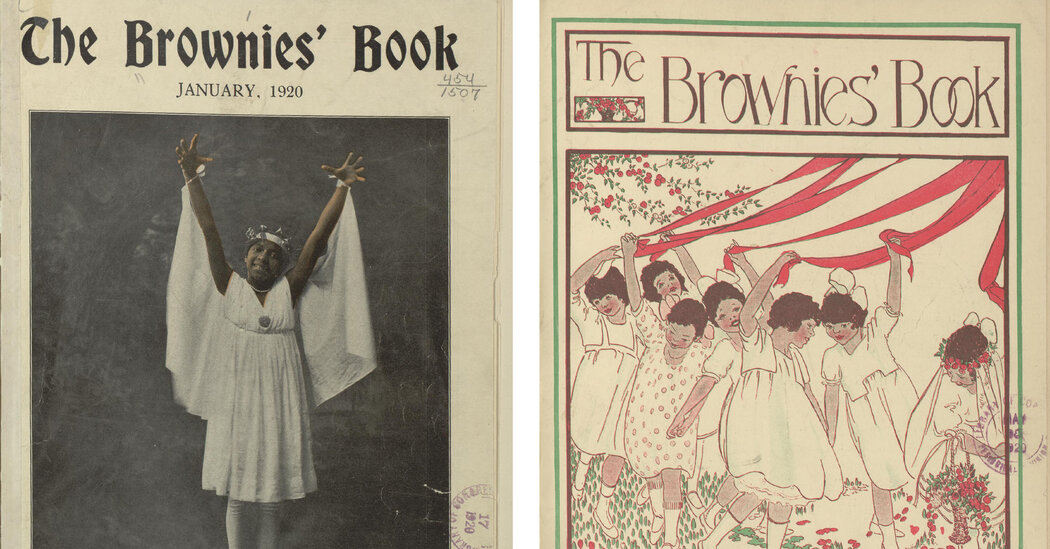
The First Magazine for Black Children Is Revisited, Its Message Still Resonant
The first magazine created especially for Black children, The Brownies’ Book, debuted in January 1920, its pages filled with the voices of children and their parents, of poets and college coeds, biographers and advice columnists, schoolgirls and scholars, spinners of fables and gatherers of folk tales, and a panoply of Black figures staking a claim in the history of a country that would rather not acknowledge them. It brimmed with playful illustrations, photographs, and travelers’ sketches. On the cover was a portrait of an adolescent ballet dancer, pearls at her neck, a crown on her head, arms aloft; a picture of self-confidence and elation.
Subtitled “A Monthly Magazine for the Children of the Sun,” The Brownies’ Book was conceived by W.E.B. Du Bois, who named the writer Jesse Redmon Fauset literary editor. It was a spinoff of the annual Children’s Number of The Crisis, the powerful and widely read house organ of the N.A.A.C.P. that Du Bois had edited since 1910, and it had a strong message to send into the headwinds of racial prejudice and post-Reconstruction violence in early 20th-century America: “to make colored children realize,” as Du Bois wrote, “that being ‘colored’ is a normal, beautiful thing.”
Langston Hughes was first published there, along with other writers and artists of the nascent movement that would come to be known as the Harlem Renaissance, Nella Larsen, Arna Bontemps and Hilda Rue Wilkinson among them. A poem by Fauset that ran in the inaugural issue served as the new venture’s dedication:
Yet despite its groundbreaking mission and cultural consequence, once The Brownies’ Book ceased publication at the end of 1921 in the wake of a nationwide depression, it languished largely forgotten by a wider public, referred to occasionally in exhibitions, in scholarly books on Black children’s literature, in children’s literature courses or in research into early Black journalism.
Now a growing interest in the historical moment exemplified by the magazine has focused wider attention on its pages, making its mission and message resonate in new ways. Karida L. Brown, a professor of sociology at Emory University and co-author of “The Sociology of W.E.B. Du Bois,” has compiled — with her husband, the artist and illustrator Charly Palmer — a tribute anthology of work by contemporary artists and writers punctuated with selections from the original magazine. “The New Brownies’ Book: A Love Letter to Black Families,” will be published on Oct. 10 by Chronicle Books.
In late August, Brown and Palmer visited the New York Public Library to see, in the “Polonsky Exhibition of The New York Public Library’s Treasures,” a copy of the May 1920 Brownies’ Book from the Schomburg Center for Research in Black Culture. On it its cover, “Winding the May Pole,” seven young brown-skinned girls in fashionable Kate Greenaway dresses daintily execute a springtime dance.
Over lunch after her visit to the library, Brown said that the genesis of “The New Brownies’ Book” was her sense that the original magazine and its context offered parallels with the present and inspiration for how to confront a corrosive turning back of the national discourse, whether in the banning of books for or about Black children, the removal of Black history from school curriculums or an ongoing news scroll of police brutality and racially-motivated violence.
“I had just witnessed George Floyd being murdered on TV, and Breonna Taylor, and, and, and,” she said. “I thought, ‘If I’m feeling this level of despair because of this, what must a Black child feel?’”
“‘The New Brownies’ Book,’” said the journalist and author Damon Young, a contributor, “is vital and critical” as a corrective and retort to the ongoing proscription of Black history and culture in library and school systems nationwide.
Brown said, “I realized that a new version of The Brownies’ Book could be, like Du Bois’s, an opportunity to say to Black children, ‘We love you, we have faith in you,’ to come not from a place of deficit and despair but of joy, love, unity and care.
Du Bois announced The Brownies’ Book in the October 1919 issue of The Crisis, just months after the so-called Red Summer, when Black troops, expecting to return from World War I to heroes’ welcomes, were met once again with bigotry and the legalized segregation of Jim Crow. Deadly race riots broke out from Washington, D.C. to Elaine, Ark., and the number of lynchings in the U.S. rose exponentially.
These atrocities were graphically chronicled in The Crisis. The Brownies’ Book wanted to shield its young readership from such content without denying either the realities of racism at home or the inequities and struggles across a globe where colonialism was being questioned. Proper parenting, it also suggested, was a civil rights pursuit.
Also urgent, Du Bois and Fauset believed, was the emotional well-being of their young readers. If Black children saw themselves represented at all in the prevailing culture of the 1920s, it was in degrading caricatures in advertising and on consumer packaging, in magazines, newspapers and children’s literature itself.
In its founding, The Brownies’ Book had a specific bone to pick with St. Nicholas Magazine, the country’s dominant children’s periodical, which even in its popular “Brownies” series — about a global mix of naughty, tannish-colored elves — excluded any of African descent, restricting fairyland itself.
The Brownies’ Book set out to counter “these gross stereotypes,” said Farah Jasmine Griffin, a professor of literature and African American studies at Columbia University, “by taking seriously the shaping of Black children’s sense of identity and self-worth.”
The magazine aimed to instill self-respect, self-assurance and a finely tuned social conscience in the next generation, a key to Black progress that would otherwise be thwarted by the forces ranged against it. A moral to its every story, it expounded on history that foregrounded Black icons and their achievements. A regular section written by Du Bois, “As the Crow Flies,” touched on headline events around the world.
“Our little girl is dark brown,” wrote Bella Seymour of New York City in a letter that ran in a section called “The Grown-ups Corner,” applauding the launch of The Brownies’ Book, “and we want her to be proud of her color and to know that it isn’t the kind of skin people have that makes them great.”
Like a run-up to the glamorous and genteel Jazz Age vignettes that the photographer James Van Der Zee captured of upper-crust Harlem, The Brownies’ Book depicted, in pictures and in prose, middle-class and aspirational working-class Black life as it thrived and strived for equality despite the obstacles in its way. Joy Bivins, the director of the Schomburg, said of her first encounter with the magazine, “the word I would use is ‘delight.’”
“It was just wonderful to see the pictures, the Black Boy Scout troop, the young girls of a debate team, the photographs from baby contests,” Bivins said. “Despite the awareness of the hardships of segregation, of discrimination, it was still kids just being kids.”
Jelani Cobb, a writer for The New Yorker and the dean of the Columbia Journalism School, sees a direct link between the magazine and Du Bois’s famous formulation from 1903, in “The Souls of Black Folk,” of “a double consciousness.”
“The Brownies’ Book is of a piece with Du Bois’s profound concern with the idea of how Black people saw themselves while also looking at themselves through the eyes of people who hated them,” Cobb said. “There’s who we are to the larger white world and who we are inwardly. The Brownies’ Book was countering the propaganda of white supremacy in both directions. It’s amazing how prescient it was.”
The closing announcement for The Brownies’ Book ran in the issue of December 1921. It would be five decades before another periodical for Black children appeared, Ebony, Jr. magazine, launched in 1973 by Johnson Publishing and folded in 1985.
“We are sorry,” Du Bois wrote in his farewell, “much sorrier than any of you, for it has all been such fun. After all — who knows — perhaps we shall meet again.” A full-page illustration by Hilda Rue Wilkinson, of a crestfallen child, was called simply, “Good-Bye.”




